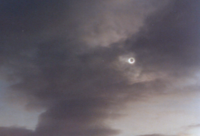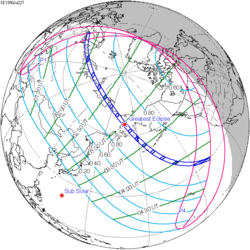| Total eclipse | |
 Totality as seen from Brandon, Manitoba | |
| Gamma | 0.8981 |
|---|---|
| Magnitude | 1.0391 |
| Maximum eclipse | |
| Duration | 169 s (2 min 49 s) |
| Coordinates | 52°06′N94°30′W / 52.1°N 94.5°W |
| Max. width of band | 298 km (185 mi) |
| Times (UTC) | |
| Greatest eclipse | 16:55:06 |
| References | |
| Saros | 120 (59 of 71) |
| Catalog # (SE5000) | 9462 |
A total solar eclipse occurred at the Moon's descending node of orbit on Monday, February 26, 1979, [1] with a magnitude of 1.0391. A solar eclipse is an astronomical phenomenon that occurs when the Moon passes between Earth and the Sun, thereby totally or partly obscuring the image of the Sun for a viewer on Earth. A total solar eclipse occurs when the Moon's apparent diameter is larger than the Sun's, blocking all direct sunlight, turning day into darkness. Totality occurs in a narrow path across Earth's surface, with the partial solar eclipse visible over a surrounding region thousands of kilometres wide. Occurring about 19 hours after perigee (on February 25, 1979, at 22:20 UTC), the Moon's apparent diameter was larger. [2]
Contents
- Visibility
- United States
- Canada
- Observations
- In literature
- Eclipse details
- Eclipse season
- Related eclipses
- Eclipses in 1979
- Metonic
- Tzolkinex
- Half-Saros
- Tritos
- Solar Saros 120
- Inex
- Triad
- Solar eclipses of 1979–1982
- Saros 120
- Metonic series
- Tritos series
- Inex series
- Notes
- References
- External links
The central shadow of the Moon passed through Washington, Oregon, Idaho, Montana (where totality covered almost the entire state), North Dakota, Saskatchewan, Manitoba, Ontario, Quebec, the Northwest Territories of Canada (the portion that is now Nunavut), and Greenland. A partial eclipse was visible for parts of North America, Central America, the Caribbean, and Western Europe.




































































































